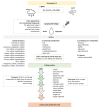Foliar Application of Sulfur-Containing Compounds-Pros and Cons
- PMID: 38005690
- PMCID: PMC10674314
- DOI: 10.3390/plants12223794
Foliar Application of Sulfur-Containing Compounds-Pros and Cons
Abstract
Sulfate is taken up from the soil solution by the root system; and inside the plant, it is assimilated to hydrogen sulfide, which in turn is converted to cysteine. Sulfate is also taken up by the leaves, when foliage is sprayed with solutions containing sulfate fertilizers. Moreover, several other sulfur (S)-containing compounds are provided through foliar application, including the S metabolites hydrogen sulfide, glutathione, cysteine, methionine, S-methylmethionine, and lipoic acid. However, S compounds that are not metabolites, such as thiourea and lignosulfonates, along with dimethyl sulfoxide and S-containing adjuvants, are provided by foliar application-these are the S-containing agrochemicals. In this review, we elaborate on the fate of these compounds after spraying foliage and on the rationale and the efficiency of such foliar applications. The foliar application of S-compounds in various combinations is an emerging area of agricultural usefulness. In the agricultural practice, the S-containing compounds are not applied alone in spray solutions and the need for proper combinations is of prime importance.
Keywords: foliar fertilization; foliar spraying; sulfur-containing adjuvants; sulfur-containing agrochemicals; sulfur-containing metabolites.
Conflict of interest statement
The authors declare no conflict of interest.
Figures

Similar articles
-
Manipulation of thiol contents in plants.Amino Acids. 2001;20(3):291-9. doi: 10.1007/s007260170045. Amino Acids. 2001. PMID: 11354605 Review.
-
Mitigation effects of foliar supply of different sulfur forms on uptake, translocation and grain accumulation of Cd and As by paddy rice on basis of liming.Sci Total Environ. 2023 Dec 20;905:167338. doi: 10.1016/j.scitotenv.2023.167338. Epub 2023 Sep 23. Sci Total Environ. 2023. PMID: 37748603
-
Foliar Spraying with Compound Amino Acid-Iron Fertilizer Increases Leaf Fresh Weight, Photosynthesis, and Fe-S Cluster Gene Expression in Peach (Prunus persica (L.) Batsch).Biomed Res Int. 2020 May 25;2020:2854795. doi: 10.1155/2020/2854795. eCollection 2020. Biomed Res Int. 2020. PMID: 32596289 Free PMC article.
-
Determination of 67Zn distribution in navy bean (Phaseolus vulgaris L.) after foliar application of 67Zn-lignosulfonates using isotope pattern deconvolution.J Agric Food Chem. 2011 Aug 24;59(16):8829-38. doi: 10.1021/jf2002574. Epub 2011 Jul 22. J Agric Food Chem. 2011. PMID: 21732694
-
From Elemental Sulfur to Hydrogen Sulfide in Agricultural Soils and Plants.Molecules. 2019 Jun 19;24(12):2282. doi: 10.3390/molecules24122282. Molecules. 2019. PMID: 31248198 Free PMC article. Review.
Cited by
-
Combined Effect of Melatonin and Sulfur on Alleviating Waterlogging Stress in Rapeseed.Plant Environ Interact. 2025 Mar 27;6(2):e70050. doi: 10.1002/pei3.70050. eCollection 2025 Apr. Plant Environ Interact. 2025. PMID: 40160887 Free PMC article.
References
-
- Fernández V., Sotiropoulos T., Brown P. Foliar Fertilization: Scientific Principles and Field Practices. 1st ed. International Fertilizer Industry Association (IFA); Paris, France: 2013.
-
- Fageria N.K., Barbosa Filho M.P., Moreira A., Guimarães C.M. Foliar Fertilization of Crop Plants. J. Plant Nutr. 2009;32:1044–1064. doi: 10.1080/01904160902872826. - DOI
-
- Niu J., Liu C., Huang K., Liu M., Yan D. Effects of Foliar Fertilization: A Review of Current Status and Future Perspectives. J. Soil Sci. Plant Nutr. 2021;21:104–118. doi: 10.1007/s42729-020-00346-3. - DOI
-
- Ishfaq M., Kiran A., ur Rehman H., Farooq M., Ijaz N.H., Nadeem F., Azeem I., Li X., Wakeel A. Foliar nutrition: Potential and challenges under multifaceted agriculture. Environ. Exp. Bot. 2022;200:104909. doi: 10.1016/j.envexpbot.2022.104909. - DOI
-
- Alshaal T., El-Ramady H. Foliar Application: From Plant Nutrition to Biofortification. Environ. Biodivers. Soil Secur. 2017;1:71–83. doi: 10.21608/jenvbs.2017.1089.1006. - DOI
Publication types
LinkOut - more resources
Full Text Sources
Miscellaneous

